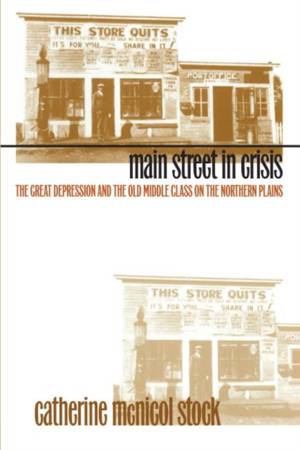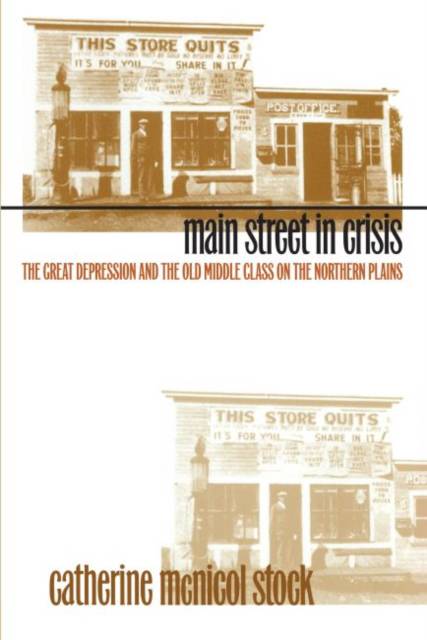
- Afhalen na 1 uur in een winkel met voorraad
- Gratis thuislevering in België vanaf € 30
- Ruim aanbod met 7 miljoen producten
- Afhalen na 1 uur in een winkel met voorraad
- Gratis thuislevering in België vanaf € 30
- Ruim aanbod met 7 miljoen producten
Zoeken
Main Street in Crisis
The Great Depression and the Old Middle Class on the Northern Plains
Catherine McNicol Stock
Paperback | Engels
€ 57,95
+ 115 punten
Omschrijving
This study of class during the Great Depression is the first to examine a relatively neglected geographical area, the northern plains states of North and South Dakota, from a social and cultural perspective. Surveying the values and ideals of the old middle class -- independent shopkeepers, artisans, professionals, and farmers -- Catherine Stock presents a picture of Dakotans' cultural life in the 1920s and 1930s and tells of their efforts to come to terms with the enormous social change brought about by the New Deal.
According to Stock, the depression not only destroyed Dakotans' economic foundations but also bankrupted their community organizations and undermined theirsocial relations. She shows that Dakotans' social values, characterized by notions of neighborliness, loyalty, hard wok, upright character, and individual enterprise, were threatedened first by devastating drought and subsequent economic collapse and then by massive relief efforts and governmental intervention on an unprecedented scale. By 1940, one-third of all farmers who owned their land had lost it to foreclosure, and the federal government had spent nearly half a billion dollars to aid the region.
Stock argues that to Dakotans, the New Deal offered a trade-off between autonomy, community, and local control, on the one hand, and survival itself on the other. Dakotans, ambivalent toward "progress," feared not only for their land, their businesses, their families, and their communities; they feared for the survival of a way of life. They responded, says Stock, by working to make sense of the new world and find renewed meaning in the old.
Consulting varied sources such as diaries, autobiographies, oral histories, and newspaper accounts, Stock includes women's voices as well as men's. She integrates female perspectives on farm life and old-middle-class community into the narrative as a whole and devotes a separate chapter to women's experiences of the upheavals produced by the Great Depression and the New Deal.
According to Stock, the depression not only destroyed Dakotans' economic foundations but also bankrupted their community organizations and undermined theirsocial relations. She shows that Dakotans' social values, characterized by notions of neighborliness, loyalty, hard wok, upright character, and individual enterprise, were threatedened first by devastating drought and subsequent economic collapse and then by massive relief efforts and governmental intervention on an unprecedented scale. By 1940, one-third of all farmers who owned their land had lost it to foreclosure, and the federal government had spent nearly half a billion dollars to aid the region.
Stock argues that to Dakotans, the New Deal offered a trade-off between autonomy, community, and local control, on the one hand, and survival itself on the other. Dakotans, ambivalent toward "progress," feared not only for their land, their businesses, their families, and their communities; they feared for the survival of a way of life. They responded, says Stock, by working to make sense of the new world and find renewed meaning in the old.
Consulting varied sources such as diaries, autobiographies, oral histories, and newspaper accounts, Stock includes women's voices as well as men's. She integrates female perspectives on farm life and old-middle-class community into the narrative as a whole and devotes a separate chapter to women's experiences of the upheavals produced by the Great Depression and the New Deal.
Specificaties
Betrokkenen
- Auteur(s):
- Uitgeverij:
Inhoud
- Aantal bladzijden:
- 320
- Taal:
- Engels
Eigenschappen
- Productcode (EAN):
- 9780807846896
- Verschijningsdatum:
- 8/09/1997
- Uitvoering:
- Paperback
- Formaat:
- Trade paperback (VS)
- Afmetingen:
- 153 mm x 230 mm
- Gewicht:
- 503 g

Alleen bij Standaard Boekhandel
+ 115 punten op je klantenkaart van Standaard Boekhandel
Beoordelingen
We publiceren alleen reviews die voldoen aan de voorwaarden voor reviews. Bekijk onze voorwaarden voor reviews.











